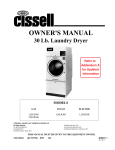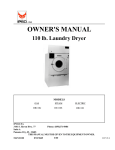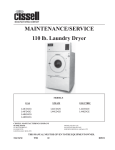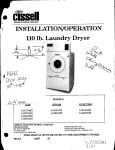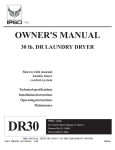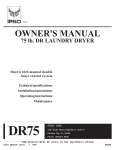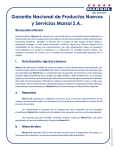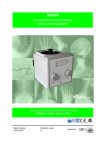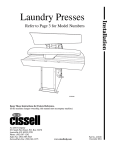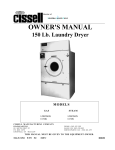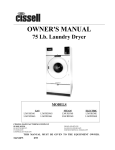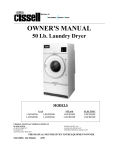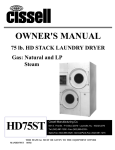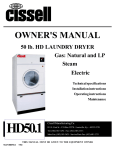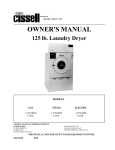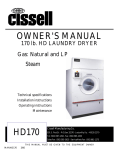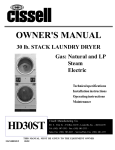Download Cissell L36FD30 Owner`s manual
Transcript
OWNER'S MANUAL 30 Lb. Laundry Dryer MODELS GAS STEAM ELECTRIC L28US30G L28UR30G L28UR30S L28UR30E CISSELL MANUFACTURING COMPANY HEADQUARTERS 831 SOUTH FIRST ST. P.O. BOX 32270 LOUISVILLE, KY 40232-2270 PHONE: (502) 587-1292 SALES FAX: (502) 585-3625 SERVICE/PARTS FAX: (502) 681-1275 THIS MANUAL MUST BE GIVEN TO THE EQUIPMENT OWNER. MAN2030 (ECN5752) 8/99 IH Page 1 IMPORTANT NOTICES—PLEASE READ For optimum efficiency and safety, we recommend that you read the manual before operating the equipment. Store this manual in a file or binder and keep for future reference. WARNING: Purchaser must post the following notice in a prominent location: WARNING: For your safety, the information in this manual must be followed to minimize the risk of fire or explosion or to prevent property damage, personal injury or death. - Do not store or use gasoline or other flammable vapors or liquids in the vicinity of this or any other appliance. - WHAT TO DO IF YOU SMELL GAS • • • • • Do not try to light any appliance. Do not touch any electrical switch; do not use any phone in your building. Clear the room, building or area of all occupants. Immediately call your gas supplier from a neighbor's phone. Follow the gas supplier's instructions. If you cannot reach your gas supplier, call the fire department. Installation and service must be performed by a qualified installer, service agency or the gas supplier. WARNING: In the event the user smells gas odor, instructions on what to do must be posted in a prominent location. This information can be obtained from the local gas supplier. WARNING: Purchaser must post the following notice in a prominent location: FOR YOUR SAFETY Do not store or use gasoline or other flammable vapors and liquids in the vicinity of this or any other appliance. WARNING: A clothes dryer produces combustible lint and should be exhausted outside the building. The dryer and the area around the dryer should be kept free of lint. WARNING: Be safe, before servicing machine, the main power should be shut off. WARNING: Wear safety shoes to prevent injuries. Page 2 ATTENTION: L’ACHETEUR DOIT PLACER L’AVERTISSEMENT SUIVANT DANS UN ENDROIT CLAIR ET VISIBLE: AVERTISSEMENT. Assurez-vous de bien suivre les instructions donnees dans cette notice pour reduire au minimum le risque d’incendie ou d’explosion ou pour eviter tuot dommage materiel, toute blessure ou la mort. __ Ne pas entreposer ni utiliser d’essence ni d’autres vapeurs ou liquides inflammables dans le voisinage de cet appareil ou de tout autre apparell. __ QUE FAIRE SI VOUS SENTEZ UNE ODEUR DE GAZ: • Ne pas tenter d’allumer d’apparell. • Ne touchez a aucun interrupteur. Ne pas vous servir des telephones se trouvant dans le batiment ou vous vous trouvez. • Evacuez la piece, le batiment ou la zone. • Appelez immediatement votre fournisseur de gaz depuis un voisin. Suivez les instructions du fournisseur. • Si vous ne pouvez rejoindre le fournisseur de gaz, appelez le service des incendies. __ l’installation et l’entretien doivent etre assures par un installateur ou un service d’entretien qualifie ou par le fournisseur de gaz. ATTENTION: L’ACHETEUR DOIT PLACER L’AVERTISSEMENT SUIVANT DANS UN ENDROIT CLAIR ET VISIBLE: POUR VOTRE SECURITE Ne pas entreposer ni utiliser d’ essence ni d’autres vapeurs ou liquides inflammables dans le voisinage de cet appareil ou de tout autre appareil. Page 3 WARNING: To avoid fire hazard, do not dry articles containing foam rubber or similar texture materials. Do not put into this dryer flammable items such as baby bed mattresses, throw rugs,undergarments (brassieres, etc.) and other items which use rubber as padding or backing. Rubber easily oxidizes causing excessive heat and possible fire. These items should be air dried. WARNING: Synthetic solvent fumes from drycleaning machines create acids when drawn through the dryer. These fumes cause rusting of painted parts, pitting of bright or plated parts, and completely removes the zinc from galvanized parts, such as the tumbler basket. If drycleaning machines are in the same area as the tumbler, the tumbler's make-up air must come from a source free of solvent fumes. WARNING: Do not operate without guards in place. WARNING: Check the lint trap often and clean as needed but at least a minimum of once per day. WARNING: Alterations to equipment may not be carried out without consulting with the factory and only by a qualified engineer or technician. Only Manufacturers parts may be used. WARNING: Remove clothes from dryer as soon as it stops. This keeps wrinkles from setting in and reduces the possibility of spontaneous combustion. WARNING: Be safe - shut main electrical power and gas supply off externally before attempting service. WARNING: Never use drycleaning solvents, gasoline, kerosene, or other flammable liquids in the dryer. FIRE AND EXPLOSION WILL OCCUR. NEVER PUT FABRICS TREATED WITH THESE LIQUIDS INTO THE DRYER. NEVER USE THESE LIQUIDS NEAR THE DRYER.. WARNING: Do not place items exposed to cooking oils in your dryer. Items contaminated with cooking oils may contribute to a chemical reaction that could cause a load to catch fire. WARNING: Never let children play near or operate the dryer. Serious injury could occur if a child should crawl inside and the dryer is turned on. WARNING: Never tumble fiberglass materials in the dryer unless the labels say they are machine dryable. Glass fibers break and can remain in the dryer. These fibers cause skin irritation if they become mixed with other fabrics. WARNING: Before operating gas ignition system - purge air from natural gas or propane gas lines per manufacturer’s instructions. WARNING: To reduce the risk of electric shock, disconnect this appliance from the power supply before attempting any user maintenance other than cleaning the lint trap. Turning the controls to the OFF position does not disconnect this appliance from the power supply. Page 4 CISSELL DRYER WARRANTY The Cissell Manufacturing Company (Cissell) warrants all new equipment (and the original parts thereof) to be free from defects in material or workmanship for a period of two (2) years from the date of sale thereof to an original purchaser for use, except as hereinafter provided. With respect to non-durable parts normally requiring replacement in less than two (2) years due to normal wear and tear, and with respect to all new repair or replacement parts for Cissell equipment for which the two (2) year warranty period has expired, or for all new repair or replacement parts for equipment other than Cissell equipment, the warranty period is limited to ninety (90) days from date of sale. The warranty period on each new replacement part furnished by Cissell in fulfillment of the warranty on new equipment or parts shall be for the unexpired portion of the original warranty period on the part replaced. With respect to electric motors, coin meters and other accessories furnished with the new equipment, but not manufactured by Cissell, the warranty is limited to that provided by the respective manufacturer. Cissell’s total liability arising out of the manufacture and sale of new equipment and parts, whether under the warranty or caused by Cissell’s negligence or otherwise, shall be limited to Cissell repairing or replacing, at its option, any defective equipment or part returned f.o.b. Cissell’s factory, transportation prepaid, within the applicable warranty period and found by Cissell to have been defective, and in no event shall Cissell be liable for damages of any kind, whether for any injury to persons or property or for any special or consequential damages. The liability of Cissell does not include furnishing (or paying for) any labor such as that required to service, remove or install; to diagnose troubles; to adjust, remove or replace defective equipment or a part; nor does it include any responsibility for transportation expense which is involved therein. The warranty of Cissell is contingent upon installation and use of its equipment under normal operating conditions. The warranty is void on equipment or parts; that have been subjected to misuse, accident, or negligent damage; operated under loads, pressures, speeds, electrical connections, plumbing, or conditions other than those specified by Cissell; operated or repaired with other than genuine Cissell replacement parts; damaged by fire, flood, vandalism, or such other causes beyond the control of Cissell; altered or repaired in any way that effects the reliability or detracts from its performance, or; which have had the identification plate, or serial number, altered, defaced, or removed. No defective equipment or part may be returned to Cissell for repair or replacement without prior written authorization from Cissell. Charges for unauthorized repairs will not be accepted or paid by Cissell CISSELL MAKES NO OTHER EXPRESSED OR IMPLIED WARRANTY, STATUTORY OR OTHERWISE, CONCERNING THE EQUIPMENT OR PARTS INCLUDING, WITHOUT LIMITATION, A WARRANTY OF FITNESS FOR A PARTICULAR PURPOSE, OR A WARRANTY OF MERCHANTABILITY. THE WARRANTIES GIVEN ABOVE ARE EXPRESSLY IN LIEU OF ALL OTHER WARRANTIES, EXPRESSED OR IMPLIED. CISSELL NEITHER ASSUMES, NOR AUTHORIZES ANY PERSON TO ASSUME FOR IT, ANY OTHER WARRANTY OR LIABILITY IN CONNECTION WITH THE MANUFACTURE, USE OR SALE OF ITS EQUIPMENT OR PARTS. For warranty service, contact the distributor from whom the Cissell equipment or part was purchased. If the distributor cannot be reached, contact Cissell. IDENTIFICATION NAMEPLATE The identification nameplate is located on the rear wall of the dryer. It contains the dryer serial number, product number, model number, electrical specifications and other important data that may be needed when servicing and ordering parts, wiring diagrams, etc. Do not remove this nameplate. Page 5 TABLE OF CONTENTS 30 LB. LAUNDRY DRYER PAGE PAGE Model Numbers & Company Address ......................................... 1 Service Savers ............................................................................ 34 Important Notices ...................................................................... 2-4 Troubleshooting ..................................................................... 35-38 Dryer Warranty ............................................................................ 5 Direct Spark Ignition .............................................................. 39-40 Table of Contents ......................................................................... 6 General Maintenance ............................................................ 41-42 Warnings, Cautionary Notes and Symbols ................................. 7-8 Burner Air Inlet Shutters Adjustment .................................... 43-44 Unpacking and General Installation .............................................. 9 Bearing Replacement Instructions .............................................. 45 Dryer Outline Dimensions (Illustration) ................................. 10-11 Basket Alignment ....................................................................... 46 General Specifications ........................................................... 12-13 Shimming the Basket and Spider Assembly ................................ 47 Main Drive Motor List ................................................................ 14 Air Switch Adjustment ............................................................... 48 General Information .................................................................... 15 Dryer - Front View ............................................................... 49-50 Grounding Instructions ................................................................ 16 Dryer - Rear View ................................................................ 51-52 Piping Recommendations ............................................................ 17 Control Panel and Access Door ............................................ 53-54 Gas Piping Installation ........................................................... 18-19 Front Panel and Door Assembly ................................................. 55 Gas Service Installation .............................................................. 20 Thermostat Assembly ................................................................. 56 Gas Pipe Size Chart .................................................................... 21 Exhaust Duct and Air Switch Assemblies .................................. 57 Steam Piping Installation ........................................................ 22-23 Steam Heating Unit .................................................................... 58 Dryer Installation with Multiple Exhaust ................................ 24-25 Gas Heating Unit ................................................................... 59-60 Dryer Installation with Separate Exhaust .................................... 26 Electric Heating Unit .................................................................. 61 Make -Up Air Requirements .......................................................... 27 Electric Bonnet “UR” Model ...................................................... 62 Exhaust and Venting ...................................................................... 28 Electric Heating Circuit .............................................................. 63 Rules for Safe Operation of Dryer .................................................. 29 Operating Instructions - Coin Meter Models ................................. 30-33 Page 6 SYMBOLS The following symbols are used in this manual and/or on the machine: Symbol Description NOTE! Hot! Do Not Touch Heiß! Nicht Beruhren Haute temperature! Ne pas toucher Caliente! no tocar dangerous voltage tension dangereuse Gefährliche elektrische Spannung tension peligrosa on marche Ein conectado off arrêt Aus desconectado start demarrage Start arranque de un movimiento emission of heat in general êmission de chaleur en general Warmeabgabe allgemein emisión de calor cooling refroidissement Kühlen enfriamiento Page 7 SYMBOLS Symbol Description rotation in two directions rotation dans les deux sens Drehbewigung in zwei Richtungen movimiento rotativo en los dos sentidos direction of rotation sens de mouvement continu de rotation Drehbewegung in Pfeilrichtung movimiento giratorio o rotatorio en el sentido de la flecha End of Cycle caution attention Achtung atencion; precaucion Page 8 UNPACKING Unpacking/General Installation (All Dryers) Upon arrival of the equipment, any damage in shipment should be reported to the carrier immediately. Upon locating permanent location of a unit, care should be taken in movement and placement of equipment. See outline clearance diagrams for correct dimensions. Remove all packing material such as: tape, manuals, skid, etc. Leveling: Use spirit level on top of dryer. Adjust leveling bolts on dryer (see adjustable leveling bolts in maintenance section). Check voltage and amperes on rating plate before installing the dryer. The construction of the dryers permits installation side-by-side to save space or to provide a wall arrangement. Position dryer for the least amount of exhaust piping and elbows, and allow free access to the rear of dryer for future servicing of belts, pulleys and motors. Installation clearance from all combustable material is 0" ceiling clearance, 0" rear clearance, and 0" side clearance. GENERAL INSTALLATION (ALL DRYERS) Before operating dryer, open basket door and remove blocking between front panel and basket. Read the instruction tags, owner's manual, warnings, etc. IMPORTANT Opening the clothes loading door deactivates the door switch to shut off the motors, fan, gas, steam, or electric element. To restart the dryer, close the door and press in the push to start button and hold briefly. IMPORTANT This dryer is designed for a capacity maximum load. Overloading it will result in long drying times and damp spots on some clothes. IMPORTANT Maximum operating efficiency is dependent upon proper air circulation. The lint screen must be kept cleaned daily to insure proper air circulation throughout the dryer. IMPORTANT Provide adequate clearance for air opening into the combustion chamber. Page 9 L28UR30 Outline Dimensions—Gas, Steam and Electric Models Page 10 L28US30 Outline Dimensions—Gas Model Page 11 General Specifications GENERAL SPECIFICATIONS FOR 30 lb. LAUNDRY DRYERS Basket Load Capacity ...................................... 30 lb (13.6 kg) Dryweight Basket Size ................................................... 27 1/4" (720 mm) Diameter x 30 1/4" (760 mm) Deep Total Amps, Voltage, Cycle ................................. Refer to rating plate on dryer Floor Space .................................................. UR models: 68 1/2” H (1740 mm) x 28 3/4" W (730 mm) x 47 1/2" Deep (1207 mm) US models: 68” H (1727 mm) x 28 3/4" W (730 mm) x 47 1/2" Deep (1207 mm) Exhaust Air Duct Size .................................. UR: 8" Diameter (203 mm) US: 6" Diameter (152 mm) Pressure Maximum ...................................... 3" Static Pressure 30 lb. GAS ENERGY-SAVER SPECIFICATIONS Maximum Air Displacement ........................ 350 cfm (595 m³/h) 30 lb. GAS (STANDARD) SPECIFICATIONS Maximum Air Displacement ........................ 700 cfm (1190 m³/h) Recommended Operating Range .................. 530-630 cfm (900-1070 m³/h) Gas Supply .................................................... 1/2" (DN15) pipe connection *Btu Input ..................................................... 100,000 Btu per hour (natural and LP gases) Electronic Ignition ....................................... Direct spark ignition system Net Weight ................................................... 437 lb (198 kg) approx. Domestic Shipping Weight .......................... 472 lb (214 kg) approx. (1 carton) Export Shipping Weight ............................... 476 lb (216 kg) approx. (1 box) Export Shipping Dimensions ....................... 74" L (1880 mm) x 31" W (787 mm) x 52" H (1321 mm) *Btu Input ..................................................... 80,000 Btu per hour (natural and LP gases) Dryer Gas Burners ....................................... Natural gas—3.5" (8.7 mbar) WC regulated pressure. LP gas—11" (27 mbar) WC gas pressure. Gas Supply .................................................... 1/2" (DN15) pipe connection Net Weight ................................................... 495 lb (225 kg) approx. Domestic Shipping Weight .......................... 526 lb (239 kg) approx. (1 carton) Export Shipping Weight ............................... 664 lb (301 kg) approx. (1 box) * Input ratings as shown are for elevations up to 2000 ft. (610 m). For elevations above 2000 ft., ratings should be reduced 4% for each 1000 ft. (305 m) above sea level. Page 12 General Specifications 30 lb. STEAM MODEL SPECIFICATIONS Maximum Air Displacement ........................ 700 cfm (1190 m³/h) Recommended Operating ............................. 530-630 cfm Range (900-1070 m³h) Steam Supply Connection ............................ 3/4" (DN20) Steam Return Connection ............................ 3/4" (DN20) Operating Steam Pressure ............................ 7-15 lb (3.18-6.9 kg) low pressure 100 lb (56.7 kg) high pressure Steam Consumption ..................................... 3.4 BHP - 117.3 lb (53.21 kg/h. with normal load - high pressure 2.6 BHP - 89.7 lb (40.69 kg/h. with normal load - low pressure Net Weight ................................................... 478 lb (217kg) Domestic Shipping Weight .......................... 522 lb (237kg) (approx. 1 carton) Export Shipping Weight ............................... 526 lb (239 kg) (approx. 1 box) Export Shipping Dimensions ....................... 74" L (1880 mm) x 35" W (889 mm) x 55" H (1397 mm) 30 LB. ELECTRIC MODEL SPECIFICATIONS Maximum Air Displacement ........................ 700 cfm (1190 m³h) Recommended Operating ............................. 530-630 cfm Range (900-1070 m³/h) Heater Input .................................................. 21 kW/h (18,061 kcal/h) Total Heater Current .................................... See chart on separate page Net Weight (approx.) ................................... 463 lb (210 kg) Domestic Shipping Weight .......................... 498 lb (226kg) (approx. 1 carton) Export Shipping Weight ............................... 513 lb (233kg) (approx. 1 box) Export Shipping Dimensions ....................... 74" L (1880 mm) x 31" W (787mm) x 52" H (1321 mm) NOTE: See electric heating unit section for further specifications. Page 13 Main Drive Motors Motor No. Voltage Hz. Phase HP kW Amps RPM MTR300 115/200-240 60 1 1/2 .37 6.2/3.1 1725 MTR300 200-240 50 1 1/2 .37 3.7 1425 MTR214 208-230/460 60 3 1/2 .37 2.5/1.1 1725 MTR302 200-240/346-415 50 3 1/2 .37 2.0/1.0 1425 MTR302 220/380 60 3 1/2 .37 1.8/0.9 1725 Note: All motors have built-in thermal overload protection. Page 14 General Information GENERAL INFORMATION The dryer is so designed that when an operator opens the dryer door, the basket and exhaust fan stops. You can expect fast drying from a laundry dryer. Hot, dry air is properly and effectively moved through the basket and exhausted through a lint trap to the atmosphere. The dryer comes equipped with an inclined, self-cleaning lint screen. In this system, lint accumulates on the underside of the screen until a blanket approximately 1/4” (6 mm) thick is formed. This blanket of lint will fall from the screen to the bottom of the dryer cabinet and should be removed daily, or as required, to prevent an over accumulation. Permanent press, durable press and other modern day fabrics require the care that your laundry dryers now provide. DRYER COOL-DOWN At the end of the drying cycle, a timed “cool-down” control automatically takes over and continues the rotation of the fan and basket without heat until the garment load reaches a safe cool temperature. This function is performed at the end of each drying cycle and continues for two minutes. Dryers must be electrically grounded by a separate #14 or larger green wire from the grounding terminal within the service connection box to a cold water pipe, or through the fourth green wire properly grounded and connected to the grounding terminal. In all cases, the Page 15 Grounding Instructions (Illustration) ELECTRICAL CONNECTIONS grounding method must comply with local electrical code requirements; or in the absence of local codes, with the National Electrical Code, ANSI/NFPA 70 or the Canadian Electrical Code, CA C22.1. See wiring diagram furnished with dryer. Your dryer is completely wired at the factory and it is only necessary for the electrician to connect the power leads to the wire connectors within the service connection box on the rear of the dryer. Do not change wiring without consulting factory as you may void the factory warranty. Do not connect the dryer to any voltage or current other than that specified on the dryer rating plate. (Wiring diagram is located on rear wall of dryer.) ELECTRICAL CONTROLS SERVICING Caution: Label all wires prior to disconnection when servicing controls. Wiring errors can cause improper and dangerous operation. Verify proper operation after servicing. Attention. Lors des operations d’entretien des commandes, etiqueter tous les fils avant de les deconnecter. Toute erreur de cablage peut etre une source de danger et de panne. Page 16 Piping Recommendations PIPING RECOMMENDATIONS 1. Trap each dryer individually. Always keep the trap clean and in good working condition. 2. When dryer is on the end of a line of equipment, extend header at least 4 feet (1.22 m) beyond dryer. Install globe valve, union, check valve and by-pass trap at end of line. If gravity return to boiler, omit trap. 3. Insulate steam supply and return line for safety of operator and safety while servicing dryer. 4. Keep dryer in good working condition. Repair or replace any worn or defective parts. STEAM HEATING UNITS 1. Keep steam coils clean. 2. Check periodically and clean as often as required. 3. Remove lint and dirt accumulation from coil fins periodically as dirty lint-laden coil fins decrease the efficiency of steamheated dryers. Page 17 Gas Piping Installation GAS PIPING INSTALLATION 1. The installation must conform with local codes, or in the absence of local codes with the National Fuel Gas Code, ANSI Z223.1 or the CAN/CGA-B149, Installation Codes. 2. Check identification nameplate for type of gas for dryer. 3. Check the altitude of dryer. 4. Check with utilities company for proper gas pressure and gas supply line. 5. Natural gas only—check the gas pressure inlet supply to dryer, 11 inches (27 mbar) water column maximum. Manifold pressure—3.5 inches (8.7 mbar) water column pressure. 6. L.P. gas only—manifold pressure—13 inches (32 mbar) water column maximum. CAUTION: Low gas pressure and intermittent gas will cause gas ignition problems and inadequate drying of laundry. Page 18 Gas Piping Installation (Illustration) The dryer and it’s individual shutoff valve must be disconnected from the gas supply piping system during any pressure testing of that system at test pressures in excess of 1/2 psi (3.5 kPa). The dryer must be isolated from the gas supply piping system by closing it's individual manual shutoff valve during any pressure testing of the gas supply piping system at test pressures equal to or less than 1/2 psi (3.5 kPa). Page 19 Gas Service Installation Instructions GAS SERVICE INSTALLATION INSTRUCTIONS The size of the gas service pipe is dependant upon many variables, such as tees, lengths, etc. Specific pipe size should be obtained from the gas supplier. Refer to the “Gas Pipe Size” chart in this manual for general gas pipe size information. CAUTION: Gas loop piping must be installed as illustrated to maintain equal gas pressure for all dryers connected to a single gas service Other gas-using appliances should be connected upstream from the loop. WARNING: LIQUIFIED PETROLEUM GASES ONLY ! GAS PRESSURE REGULATOR FOR LIQUIFIED PETROLEUM GASES A gas pressure regulator for liquified petroleum gases is not furnished on gas heated clothes dryers. This regulator is normally furnished by the installer. In accordance with American Gas Association (AGA) standards, a gas pressure regulator, when installed indoors, must be equipped with a vent limiter or a vent line must be installed from the gas pressure regulator vent to the outdoors. Page 20 Gas Pipe Size Chart TOTAL BTU/HR (for LP Gas correct total BTU/HR below by multiplying by .6) GAS PIPE SIZE FOR 1000 BTU (250 KCAL) NATURAL GAS AT 7” (17.8 CM) W.C. PRESSURE TOTAL KCAL In figuring total length of pipe, make allowance for tees and elbows. (50 ft.) (75 ft.) (100 ft.) (125 ft.) 15,24 m 22,86 m 30,48 m 38,1 m HOUR (25 ft.) 7,62 m (150 ft.) 45,72 m 60,000 15000 3/4 3/4 3/4 3/4 3/4 3/4 80,000 20000 3/4 3/4 3/4 1 1 1 100,000 25200 3/4 3/4 1 1 1 1 120,000 30200 3/4 1 1 1 1 1 140,000 35200 3/4 1 1 1 1 1 1/4 160,000 40300 3/4 1 1 1 1/4 1 1/4 1 1/4 180,000 45300 1 1 1 1 1/4 1 1/4 1 1/4 200,000 50400 1 1 1 1/4 1 1/4 1 1/4 1 1/2 300,000 75600 1 1 1/4 1 1/4 1 1/2 1 1/2 1 1/2 400,000 100800 1 1/4 1 1/4 1 1/2 1 1/2 1 1/2 2 500,000 126000 1 1/4 1 1/2 1 1/2 2 2 2 600,000 151200 1 1/2 1 1/2 2 2 2 2 700,000 176400 1 1/2 2 2 2 2 2 1/2 800,000 202000 1 1/2 2 2 2 2 1/2 2 1/2 900,000 230000 2 2 2 2 1/2 2 1/2 2 1/2 1,000,000 250000 2 2 2 2 1/2 2 1/2 2 1/2 1,100,000 270000 2 2 2 1/2 2 1/2 2 1/2 2 1/2 1,200,000 300000 2 2 2 1/2 2 1/2 2 1/2 2 1/2 1,300,000 330000 2 2 1/2 2 1/2 2 1/2 2 1/2 3 1,400,000 350000 2 2 1/2 2 1/2 2 1/2 3 3 1,500,000 380000 2 2 1/2 2 1/2 2 1/2 3 3 1,600,000 400000 2 2 1/2 2 1/2 3 3 3 1,700,000 430000 2 2 1/2 2 1/2 3 3 3 1,800,000 450000 2 1/2 2 1/2 3 3 3 3 1,900,000 480000 2 1/2 2 1/2 3 3 3 3 2,000,000 504000 2 1/2 2 1/2 3 3 3 3 1/2 2,200,000 550000 2 1/2 3 3 3 3 1/2 3 1/2 2,400,000 605000 2 1/2 3 3 3 3 1/2 3 1/2 2,600,000 650000 2 1/2 3 3 3 1/2 3 1/2 3 1/2 2,800,000 705000 2 1/2 3 3 3 1/2 3 1/2 3 1/2 3,000,000 750000 2 1/2 3 3 1/2 3 1/2 3 1/2 4 3,200,000 806000 3 3 3 1/2 3 1/2 3 1/2 4 3,400,000 850000 3 3 1/2 3 1/2 3 1/2 4 4 3,600,000 907000 3 3 1/2 3 1/2 3 1/2 4 4 3,800,000 960000 3 3 1/2 3 1/2 4 4 4 4,000,000 1000000 3 3 1/2 3 1/2 4 4 4 Page 21 Steam Piping Installation Instructions STEAM PIPING INSTALLATION INSTRUCTIONS 1. Set and anchor dryer in position. Machine should be level to assure proper steam circulation. 2. To prevent condensate draining from headers to dryer, piping should have a minimum 12" (305 mm) above respective header. Do not make steam connection to header with a horizontal or downwardly facing tee or elbow. 3. Whenever possible, horizontal runs of steam lines must drain, by gravity, to respective steam header. Water pockets, or an imporperly drained steam header will provide wet steam, causing improper operation of dryer. If pockets or improper drainage cannot be eliminated, install a by-pass trap to drain condensate from the low point in the steam supply header to the return. 4. In both steam supply and steam retyrn line, it is recommended that each have a 3/4" (DN 20) union and 3/4" (DN 20) globe valve. This will enable you to disconnect the steam connections and service the dryer while your plant is in operation. 5. Before connecting trap and check valve to dryer, open globe valve in steam supply line and allow steam to flow through dryer to flush out any dirt and scale from dryer. This will assure proper operation of trap when connected. 6. After flushing system, install bucket trap (with built-in strainer) and check valve. For successful operation of dryer, install trap 18" (457 mm) below coil and as near to the dryer as possible. Inspect trap carefully for inlet and outlet markings and install according to trap manufacturer's instructions. If steam is gravity returned to boiler, omit trap but install check valve in return line near dryer. 7. Install union and globe valve in return line and make final pipe connections to return header. Page 22 Steam Piping Installation (Illustration) Page 23 Dryer Installation With Multiple Exhaust For Exhaust Duct less than 14 feet (4.3 m) and 2 elbows equivalent and less than 0.3 inches (7.6 mm) water column static pressure. DRYER EXHAUSTS Area of section “A-A” must be equal to the sum of dryer exhaust pipes entering multiple exhaust pipe. (See chart below.) No. of dryers Duct diameter (in inches) 6 9 11 12 14 15 16 17 18 19 20 21 22 23 23 24 25 26 26 27 28 28 29 30 15 23 27 30 35 38 41 43 46 48 51 53 56 58 58 61 63 66 66 68 71 71 73 76 (in cm) No. of dryers Duct diameter (in inches) (in cm) No. of dryers Duct diameter (in inches) MODELS: L28CD30, L28UR30, L36CD30, L36UR30, L36UR36, L36AR36, L44FD42 1 2 3 4 5 6 7 8 9 10 11 12 13 14 15 16 17 18 19 20 21 22 23 24 8 12 14 16 18 20 22 23 24 26 27 28 29 30 31 32 33 34 35 36 37 38 39 40 20 30 25 41 46 51 56 58 61 66 68 71 73 76 78 81 84 86 89 91 94 97 99 100 MODELS: L44CD42, L50CD42 1 2 3 4 5 6 7 8 9 10 11 12 12 17 21 24 27 30 32 34 36 38 40 42 30 43 53 61 68 76 81 86 91 97 100 106 AUTOMATIC ELECTRICAL CONTROL FOR EXHAUST FAN For one or more dryers to start fan. Exhaust Booster Fan Start and Stop Switches on Dryers Page 24 ____ ____ ____ ____ Relay Coils ____ Power Supply to Fan ____ (in cm) MODELS: L28FD30, L28US30, L36FD30, L36US30, L36US36, L44FD42 1 2 3 4 5 6 7 8 9 10 11 12 13 14 15 16 17 18 19 20 21 22 23 24 Dryer InstallationWith Multiple Exhaust DRYER INSTALLATION WITH MULTIPLE EXHAUST For Exhaust Duct more than 14 feet (5 m) and 2 elbows equivalent and more than 0.3 inches (8 mm) water column static pressure. (See illustration on next page.) 1. 2. 3. 4. 5. 6. 7. Make-up air from outside building may enter enclosure from top or side walls. (See Dryer Make-up Air Requirements Chart) Use constant diameter duct with area equal to the sum of dryer duct areas. EXAMPLE: 6-8 inches (203 mm) diameter duct = 1-19.6 inches (498 mm) diameter duct in area. Use 20 inches (508 mm) diameter duct or diameter to match tube-axial fan. Enclosure (plenum) with service door. This separates the dryer air from room comfort air. If dryers use room air instead of outside air, the heat loss can be another 25 Btu/h (6.3 kcal/h) for each cubic foot per minute (cfm) used. Zero inches clearance to combustible material allowed on sides and at points within 4 inches (100 mm) of front on top. Heat loss into laundry room from dryer fronts only is about 60 Btu/h per square foot (15 kcal/h per 0.1m²). Flange mounted, belt driven tube-axial fan. Fan must run when one or more dryers are running. See suggested Automatic Electrical Control Wiring Diagram on previous page. Must meet local electrical codes. Fan air flow (cfm) (m³/h.) is equal to sum of dryer air flows, but static pressure (SP) is dependent on length of pipe and number of elbows. Barometric bypass damper—Adjust to closed flutter position with all dryers and exhaust fan running. Must be located within enclosure. CAUTION: Never install hot water heaters or other gas appliances in the same room as dryers. Never install cooling exhaust fans in the same room as dryers. CAUTION: Never exhaust dryers with other types of equipment. Page 25 Dryer Installation With Separate Exhaust (Preferred) DRYER INSTALLATION WITH SEPARATE EXHAUST (PREFERRED) For ductwork less than 14 feet (5 m) and 2 elbows equivalent and less than 0.3 inches (8 mm) water column static pressure: NEVER exhaust the dryer into a chimney. NEVER install wire mesh screen over the exhaust or make-up air area. NEVER exhaust into a wall, ceiling, or concealed space. 1. 2. 3. 4. Make-up air opening from outside the building may enter the enclosure from the top or side walls. (See Dryer Make-up Air Requirements Chart) Enclosure (plenum) with service door. This separates the dryer air from the room comfort air. If dryers use room air instead of outside air, additional heat loss can be another 25 Btu/h (6.3 kcal/h) for each cubic foot per minute (cfm) (1.8 m³/h) used. Zero inches (mm) clearance to combustible material allowed on sides and at points within 4 inches (100 mm) of front on top. Heat loss into laundry room from dryer front panels is about 60 Btu/h per square foot (15 kcal/h per 0.1m²). Page 26 Suggested Minimum Dryer Make-up Air Requirements Dryer Model C 30 C 30 E/S C 30 ST C 50 C 50 E/S C 75 C 75 E/S C 75 ST HD80 C 110 C 110 E/S C 125 C 150 HD175 HD190 WMC/HD20 WMC/HD30 WMC/HD50 WMC/HD75 Dryer Pocket Capacity lb 30 30 30 50 50 75 75 75 80 110 110 125 150 175 190 20 30 50 75 kg 13.6 13.6 13.6 22.7 22.7 34 34 34 36.3 50 50 56.7 68 79.4 86.2 9.1 13.6 22.7 34 Maximum Air Flow Rate per Pocket cfm m3/h 700 1190 400 680 450 765 800 1360 450 765 1000 1700 536 911 1000 1700 1465 2490 2200 3740 850 1445 2000 3400 2250 3825 2780 4726 3000 5100 450 765 625 1063 700 1190 750 1275 Duct Size For Service Connection inch mm 8 203 6 153 6 153 8 203 6 153 8 203 6 153 12 305 10 254 12 305 8 203 12 305 12 305 12 305 12 305 6 153 8 203 8 203 8 203 Required Make-up Air Area per Pocket sq. inch cm2 135 871 77 497 87 561 154 994 87 561 192 1239 103 665 192 1239 282 1819 422 2723 163 1052 384 2477 432 2787 534 3445 576 3716 87 561 120 774 135 871 144 929 Notes: 1) The Model C 30 ST has 2 pockets per dryer, each pocket has the above listed characteristics; each pocket is exhausted separately with a 6" (152 mm) duct. 2) The Model C 75 ST has 2 pockets per dryer, each pocket has the above listed characteristics; both pockets have one 8" (203 mm) exhaust manifolded into one 12" (305 mm) exhaust duct for connection. 3) For the C 30 ST and the C 75 ST Models, the Required Make-up Air Area shown in the table should be doubled since it is shown per pocket, only. 4) E/S indicates an Energy Saving Model. Page 27 Exhaust and Venting DRYER AIR FLOW INSTALLATION Nothing is more important than air flow for the proper operation of a clothes dryer. A dryer is a pump which draws make-up air from the out-of-doors, through the heater, through the clothes and then forces the air through the exhaust duct back to the out-of-doors. Just as in a fluid water pump, there must be a fluid air flow to the inlet of the dryer, if there is to be the proper fluid air flow out of the exhaust duct. In summary, there must be the proper size out-of-doors inlet air opening 4-6 times the combined areas of the air outlet) and an exhaust duct, size and length of which allows flow through the dryer with no more than 0.3 inches (7.6 mm) water column static pressure in the exhaust duct. In some instances, special fans are required to supply make-up air, and/or boost exhaust fans are required for both regular and energy saving models. EXHAUST DUCT FOR BEST DRYING: 1. Exhaust duct maximum length 14 feet (4.3 m) of straight duct and maximum of two 90° bends. 2. Use 45° and 30° elbows wherever possible. 3. Exhaust each dryer separately. 4. Use 2 feet (0.6 m) of straight duct on dryer before installing an elbow on Energy-Saver models only. 5. Do not install wire mesh or other restrictions in the exhaust duct. 6. Use clean-outs in the exhaust duct and clean periodically when needed. 7. Never exceed 0.3 inches (7.6 mm) water column static pressure in the exhaust duct. 8. Inside surface of the duct must be smooth. 9. Recommend pop rivets for duct assembly. MAKE-UP AIR FOR BEST DRYING: 1. Provide opening to the out-of-doors in accordance with the following: For each dryer— 6 inches (152 mm) diameter exhaust requires a 1 square feet (0.1 m²) opening for make-up air. 8 inches (203 mm) diameter exhaust requires a 2 square feet (0.2 m2) opening for make-up air. 12 inches (305 mm) diameter exhaust requires a 4 square feet (0.4 m2) opening for make-up air. 2. Use barometric shutters in the inlet air opening to control air when dryers are not running. OTHER RECOMMENDATIONS Other Recommendations To assure compliance, consult local building code requirements. TROUBLESHOOTING Troubleshooting Hot dryer surfaces, scorched clothes, slow drying, lint accumulations, or air switch malfunction are indicators of exhaust duct and/or make-up air problems. Page 28 Rules for Safe Operation of Dryer RULES FOR SAFE OPERATION OF DRYER 1. 2. 3. 4. 5. 6. 7. 8. 9. ENERGY-SAVING TIPS 1. 2. 3. 4. 5. 6. Be sure your dryer is installed properly in accordance with the recommended instructions. CAUTION Be safe—shut main electrical power supply and gas supply off externally before attempting service. CAUTION Never use drycleaning solvents: gasoline, kerosene, or other flammable liquids in the dryer. Fire and explosion will occur. Never put fabrics treated with these liquids into the dryer. Never use these liquids near the dryer. Always keep the lint screen clean. Never use heat to dry items that contain plastic, foam or sponge rubber, or rags coated with oils, waxes or paints. The heat may damage the material or create a fire hazard. Rubber easily oxidizes, causing excessive heat and possible fire. Never dry the above items in the dryer. Never let children play near or operate the dryer. Serious injury will occur if a child should crawl inside and the dryer is turned on. Never use dryer door opening and top as a step stool. Read and follow manufacturer’s instructions on packages of laundry and cleaning aids. Heed any warnings or precautions. Never tumble fiberglass materials in the dryer unless the labels say they are machine dryable. Glass fibers break and can remain in the dryer and could cause skin irritation if they become mixed into other fabrics. Reference: Lighting and shut-down instructions and wiring diagrams are located on the rear wall of the dryer cabinet. The dryer must not be installed or stored in an area where it will be exposed to water and/or weather. Install dryer so that you can use short, straight venting. Turned elbows and long vent tubing tend to increase drying time. Longer drying time means the use of more energy and higher operating costs. Operate dryer using full-size loads. Very large loads use extra energy. Very small loads waste energy. Dry light-weight fabrics separately from heavy fabrics. You will use less energy and get more even drying results by drying fabrics of similar weight together. Clean the lint screen area daily. A clean lint screen helps give faster, more economical drying. Do not open the dryer door while drying. You let warm air escape from the dryer into the room. Unload the dryer as soon as it stops. This saves having to re-start your dryer to remove wrinkles. Page 29 Operating Instructions—Coin Meter Models OPERATING INSTRUCTIONS—COIN METER MODELS OPERATING INSTRUCTIONS—COIN METER MODELS 1. After loading the dryer with water washed clothes, close the loading door. 2. ELECTRO-MECHANICAL COIN METER: Insert proper coin(s) in slot and turn knob until it stops. COMPUTERIZED COIN METER: Insert coin. Amount of drying time will appear on the digital display. Maximum time is 99 minutes. Additional coins may be vended any time during the cycle. 3. Select temperature setting using proper push button. HIGH—185° F (85° C) exhaust temperature, heavy fabrics and hard to dry, (cottons and linens). MEDIUM—150° F (66° C) exhaust temperature, permanent press, synthetic blends. LOW—135° F (57° C) exhaust temperature, delicate, sheer fabrics. 4. Press the “Start” button to start the drying and cooling cycles. ELECTRO-MECHANICAL COIN METER COMPUTERIZED COIN METER WHAT IS HAPPENING AFTER STEP 4: 1. Digital Display will count down time remaining in cycle (Computerized Coin Meter). 2. The fan motor and basket will revolve. 3. The heat source will be energized. 4. The heated air will mix with the wet clothes and evaporate the moisture. 5. The thermostats will operate at a safe temperature. 6. The heat will shut off and the cooling cycle will begin. Page 30 Operating Instructions—Coin Meter Models IMPORTANT IMPORTANT If the tumbler door is opened during the drying cycle, the fan and heat will shut off. Press “START” button to resume the cycle. This dryer is designed for a capacity maximum load. Overloading it will result in longer drying time and damp spots on some of the load. Maximum operating efficiency depends on proper air flow. The lint screen must be kept clean daily to insure proper circulation of air throughout the dryer. This commercial dryer has keys for the lint door and access door to burners and controls. This is for the safety of the user. Page 31 Setting Time On Computerized Coin Meter (Illustration) COMPUTERIZED COIN METER DIP Switch Banks are located here Page 32 Setting Time On Computerized Coin Meter INSTRUCTIONS FOR SETTING TIME ON COMPUTERIZED COIN METER 1. This control is equipped with two banks of four DIP switches. 2. Each DIP switch bank consists of 4 small switches each with a specified amount of time (minutes), as shown: ON OFF 1 min. 8 min. 4 min. 2 min. 3. To set the time on the DIP bank simply set the appropriate switch to the ON (up) position to total the desired amount of time. NOTE OFF (down) position equals 0 minute. EXAMPLE: 25¢ for 12 minutes MINUTES: 0 + 0 + 4 + 8 Page 33 = 12 min. Service Savers TROUBLESHOOTING To help you troubleshoot the dryer, we list below the most common reasons for service calls and some answers to the problems. Before you call service, please review the following items: DRYER WON’T START DRYER WON’T START 1. Is the door completely closed? 2. Are the controls set to the “on” position? 3. Did you push the “start” control? 4. Has a fuse blown or a circuit breaker tripped? 5. Are the fuses tight? 6. Check for low voltage. 7. Has the bonnet thermostat (gas only) tripped? If so, push to reset. DRYER WON’T HEAT DRYER WON’T HEAT 1. Is the dryer set for “cooling time” rather than “drying time”? 2. Are the gas valve in the dryer and the valve on the main gas line turned on? 3. Check for low or intermittant gas pressure. 4. Check spark ignition module diagnostic light. CLOTHES ARE NOT SATISFACTORILY DRY CLOTHES ARE NOT SATISFACTORILY DRY 1. Timed cycle—Did you allow enough heating time before the cool-down part of the cycle? 2. Is the lint screen blocked? 3. Is the exhaust duct to the outside clean and not blocked? (A blocked exhaust will cause slow drying and other problems.) GAS DRYER IGNITION GAS DRYER IGNITION Refer to the page on “Instructions for the Direct Ignition System Operation”. Check to see if the manual gas valve is open. Then reset the dryer controls. All panels, covers, and doors must be in place and closed before starting the dryer. VERY IMPORTANT VERY IMPORTANT When calling the factory for service, always refer to the model number and serial number. Page 34 Troubleshooting Chart Troubleshooting Chart TROUBLE Motor will not start. CAUSE REMEDY No power. Incorrect power. Time off. Loose wiring connections. Loading door open. Door switch out of adjustment. Defective door switch. Defective basket motor contactor. Motor tripping on thermal. Tripped/defective safety thermostat Reset/replace thermostat. on gas bonnet. Check voltage at motor terminals. Voltage must be Low voltage. within + 10% of voltage shown on motor rating plate. If not, check with local power company for recommended corrective measures. Inadequate wiring. Poor housekeeping. Check with local power company to insure that wiring is adequately sized for load. Check all electrical connections and tighten any loose connections. Check installation sheet for recommended make-up air openings. Clean lint accumulation on and around motors. Defective timer. Replace timer. V-belt broken. V-belt loose. Motor pulley loose. Basket overloaded. Replace V-belt. Adjust belt tension. Tighten set screw. Remove load. Loose connections. Inadequate air. Dryer does not stop at end of time period. Motor runs but basket will not revolve. Check fuses on circuit breakers. Make sure main control switch is “on”. Check bonnet thermostat (gas only). Check power source; voltage, phase and frequency must be the same as specified on electrical rating plate. Check timer for proper setting or check coin meter for properly vending. Check wire connections in electrical box on rear of dryer. Close door. Adjust switch by removing front panel and bend actuator lever to clear switch button 3/8" with front panel in place. Replace switch. Replace contractor. Page 35 Troubleshooting Chart Troubleshooting Chart TROUBLE CAUSE Dryer noisy or vibrating. Not leveled. Fan out of balance. Check manual for proper leveling procedures. Accidental damage to the fan blade can change the dynamic balance. Damaged fans should be replaced. Basket rubbing. Adjust basket clearance. V-belt sheaves. Tighten set screws. Make sure sheaves are in proper alignment. Adjust belt tension. Occasionally screws, nails, etc, will hang in the basket perforations and drag against the sweep sheets surrounding the basket. Such foreign objects should be removed immediately. Check for correct control voltage - 120V. Check power supply, check secondary voltage on transformer and check wiring and wiring diagram. Belt. Foreign objects. Dryer runs, but no heat. REMEDY Incorrect voltage. No voltage. Direct spark ignition module defective. Defective gas valve. Gas turned off. Defective door switch. Air switch not operating. Replace direct spark ignition module. Replace coil assembly. Turn manual gas valve on. Replace door switch. Clean out lint compartment daily. Check back draft damper for foreign objects, lint accumulation or other causes that may prevent damper from opening. Check duct work for lint build-up. Check installation sheet to insure that duct work and make-up air openings are adequately sized. Check exhaust outlet. If a screen has been improperly installed on the outlet, it may be clogged with lint or frozen over in winter. NEVER install a screen on the exhaust outlet. Vacuum within dryer drops to .09 inches of water column, or less, for normal operation of dryer. Vacuum reading (in inches of water) should range between .15 and .3 inches. Vacuum reading can be made with a vacuum U-gauge by removing a sheet metal screw in the front panel of dryer and inserting the rubber tube of the vacuum gauge into screw opening. Page 36 Troubleshooting Chart Troubleshooting Chart TROUBLE Dryer runs, but no heat. (continued) Main burners burning improperly. Main burner cycles on and off. Low or high gas flame. CAUSE REMEDY Air switch out of adjustment. Air switch defective. Gas pressure too low. See air switch adjustment sheet. Replace air switch. Check manifold pressure and adjust to pressure specified on rating plate. If this pressure cannot be obtained, have gas supplier check main pressure. Improper orifice. Orifices have been sized for type of gas specified on rating plate. Check with gas supplier to determine specifications for gas being used. If different from rating plate, contact factory and obtain proper orifices. Electric power to heating unit turned off. Line fuse or heater circuit fuse blown to unit. Defective relay. Defective electric elements. Defective thermostat. Defective safety overload thermostat. Lint compartment door open. Burner air shutters closed. Dirt in burner. High gas pressure. Orifice too large. Restricted or blocked exhaust. Direct spark ignition defective. Incorrect main burner orifices. Turn power on. Replace Replace Replace Replace Replace fuse. relay. elements. thermostat. thermostat. Close door. Open for blue flame. Blow out. Adjust gas pressure per rating plate. Send to factory for correct orifices. Clean exhaust. Replace direct spark igniter. Replace orifices. Check factory for correct size. Page 37 Troubleshooting Chart Troubleshooting Chart TROUBLE Dryer too hot. CAUSE REMEDY Incorrect main burner orifice. Replace orifices. Check factory for correct size. Inadequate make-up air. Make-up air must be 4 to 6 times the exhaust area of the dryer. Remove lint. Must be full open or replace. Adjust gas pressure per rating plate. Check service section for recommended sizes. Remove obstructions or lint build up from duct work. NEVER use smaller size exhaust duct. ALWAYS use larger size. Replace thermostat. Check all valves in steam supply and return. Make sure they are open. Remove and clean. Replace if defective. On dryers using solenoid temperature control, check operation of solenoid valve by advancing thermostat. On dryers using solenoid temperature control, thermostat controls operation of solenoid valve. If defective, replace thermostat. Check for inlet and outlet marking on check valve and invert if necessary. Remove plug and blow down strainer or remove and clean thoroughly if heavily clogged. Lint accumulated. Exhaust duct dampers. High gas pressure. Partially restricted or inadequately sized exhaust system. Dryer runs no steam to coils. Defective thermostat. Valve closed. Steam trap blocked. Solenoid valve. Thermostat. Check valve installed incorrectly. Strainer clogged. Water in steam line. Steam piping installed incorrectly. Trap not functioning. Check piping per steam installation instructions. Check trap for size and capacity. If dirty and sluggish, clean thoroughly or replace. Check return line for high back pressure, or another trap charging against the trap functioning improperly. Page 38 Direct-Spark Ignition Operation DIRECT SPARK IGNITION OPERATION NOTE: Some models are equipped with a dual ignition system. The dual ignition system contains two direct spark ignition modules in parallel. Each module has its own flame sense circuit and acts independently of the other. If either bonnet limit thermostat opens because of high heat or flame impingement, the entire ignition system will shut down. 1. When a call for heat is received from the control supplying 24VAC to the ignition control module, the pre-purge delay timer begins. This delay time allows any air/sediment to be ejected prior to burner ignition. Following the pre-purge delay period, the gas valve is energized and the spark ignitor sparks for the trial ignition period. 2. When a flame is detected during the trial for ignition period, the spark ignitor shuts off and the gas valve remains energized. 3. If no flame is detected by the flame sense circuit, the ignition control module will go into safety lockout. The valve will be turned off immediately. If the module has multiple retries and no flame is detected, the gas valve is de-energized and the module goes into an interpurge delay. After this delay, the module will attempt another trial for the ignition period. This will continue until the number of retries has been used up. At the time, the module will go into safety lockout. 4. Recovery from safety lockout requires one of the following: a. A manual reset by opening and closing the loading door. b. After one hour if the control thermostat is still calling for heat, the module will automatically reset and the trial for ignition period will start over. 5. Opening the loading door will cause the flame to extinguish. Closing the door and starting the dryer will restart the trial for ignition period. 6. Once the control thermostat has been satisfied and/or the drying timer has been timed out, the ignition control module(s) will be de-energized, the gas valve(s) will be deenergized and the flames will extinguish. 7. The machine will continue to run in a cooldown mode without heat. This process will cool the load to the touch and help to eliminate wrinkling. Page 39 DIRECT SPARK IGNITION OPERATION FLOW CHART Page 40 General Maintenance GENERAL MAINTENANCE 1. Clean lint trap daily. Remove lint before or after each day of operation. A clean lint trap will increase the efficiency of the dryer and the moisture-laden air will be exhausted outside more quickly. 2. Keep basket and sweep sheets clean. Clean as often as needed. The basket and sweep sheets are accessible by removing the front panel of the dryer. 3. Gas burners, steam coils, electric coils. Check and clean often. 4. Pulleys and belts. Keep clean as oil and dirt will shorten the life of a belt. Check periodically for alignment. Pulley shafts must be parallel and the grooves must be aligned. Check belt tension periodically. Adjust tension by movement of idler bracket. Lubricate idler pulley once every two months using six grams of high temperature grease. Do not over-grease. 5. Electric motor. Keep motor clean and dry. Motors are packed with sufficient grease for 10 years normal service. After that, bearings and housing should be cleaned and repacked one third full with Chevron grease No. SR1-2. See label on motor for further information. If motor overheats, check voltage and wiring. Low voltage, inadequate wiring and loose connections are the main cause of motor failures. 6. Adjustable leveling bolts. One at each corner permits accurate alignment of dryer. To adjust: Block one corner of dryer up off the floor, loosen hex nut. With wrench, turn bolt clockwise to raise dryer, opposite to lower. Rear bolts are outside of dryer and front bolts are inside lint trap compartment. Page 41 General Maintenance GENERAL MAINTENANCE 7. Periodically clean and examine exhaust system. 8. Keep dryer area clean and free of gasoline, combustible materials and other flammable liquids or vapors. 9. Do not obstruct the flow of combustion (make-up) air and ventilating air. 10. Check gas pressure periodically. 11. Gas burners air inlet shutters can be adjusted for proper flame by following instructions outlined on separate page of this manual. 12. Main Basket Bearings. Lubricate once every six months using six grams of high temperature grease. Do not overgrease. 13. Steam Heating Units. Keep steam coils clean. Check periodically and clean as often as required. Remove lint and dirt accumulation from coil fins to avoid decreasing their efficiency. 14. Clean Out Panel (Energy Saver Gas Models Only). Remove this panel located on the energy saver heating unit and clean the inside area of lint and dirt on a regular basis. Page 42 Burner Air Inlet Shutter Adjustment BURNER AIR INLET SHUTTER ADJUSTMENT Burner air inlet shutters are correctly adjusted when the flame is primarily blue. TYPE OF GAS Natural gas Liquid petroleum Manufactured gas AIR SHUTTER ADJUSTMENT BURNER AIR INLET SHUTTER ADJUSTMENT 1/2 Open 1/4 Open 1/16 Open AIR SHUTTER ADJUSTMENT: Proper Method Close air shutters to yellow tip, then open air shutters to blue flame tip. Orange tips are impurities in the air such as lint, dust, etc. CORRECT Page 43 Burner Air Inlet Shutter Adjustment BURNER AIR INLET SHUTTER ADJUSTMENT Burner air inlet shutters are adjusted closed. Insufficient air is admitted through the burner. Flame pattern is straight up and flame is yellow. WRONG—NEED TO ADJUST SHUTTER BURNER AIR INLET SHUTTER ADJUSTMENT This flame pattern indicates the burner air inlet shutters are correctly adjusted, but air through the dryer is insufficient. This condition indicates excessive lint in the lint compartment, lack of make-up air in the room, restricted exhaust duct, or a vacuum in the room caused by an exhaust fan. WRONG—NEED TO PROVIDE CORRECT AIRFLOW THROUGH THE DRYER Page 44 Bearing Replacement Instructions BEARING REPLACEMENT INSTRUCTIONS Step 1 Step 2 Step 3 Step 4 Step 5 Step 6 Remove belt guard, V-belt, spacer and basket sheave. Loosen set screws on the flange bearing and on the pillow block bearing. Remove the bolts holding the pillow block bearing and take it off the shaft. Remove the nuts and washers holding the flange basket bearing and take it off the dryer. Inspect the bearings for damage and replace as necessary, in reverse order of removing them. Before tightening securely, align basket per instructions on separate instruction sheet. Lubrication guide---Bearings never need lubrication. They have been permanently lubricated by the supplier with a high temperature grease. Page 45 Basket Alignment Instructions BASKET ALIGNMENT INSTRUCTIONS Step 1 Step 2 Step 3 Loosen the set screws on the flange and pillow block bearings. Loosen the 4 side bolts, “1, 2, 3, 4” on the basket bearing bracket. (see figure 3) Loosen the two adjusting bolts and locknuts “5, 6” inside the bracket. Loosen the bolts “7” on the pillow block bearing. Place one “A” and two “B” diameter pins inside the drying compartment between the rim of the basket opening and the rim of the door opening in the positions shown in figures 1 and 2. Check the two “B” pins for equal clearance. NOTE Push the basket toward the rear Step 4 Step 5 Step 6 With the pins in position, tighten the set screws on the bearing races. Tighten the side bolts “1, 2, 3, 4” in numerical order. Tighten the bolts “7” on the pillow block bearing. And tighten the bolts “5” and locknuts “6.” Remove the aligning pins. CAUTION Check to see that the set screws are wrench tight on the bearings. Page 46 Basket Shimming Instructions BASKET SHIMMING INSTRUCTIONS This procedure is normally necessary when replacing either the basket or the spider assembly on any dryer. Proper shimming is crucial to obtain a true running basket. A. Align the basket as per instructions in the manual. B. Rotate the basket to determine where the most out-of-round point is (where the basket scrapes or comes closest to scraping the sweep sheet). C. Mark this position and the nearest rib to this position. D. Remove the basket (do not loosen the alignment bolts). E. With the basket on the floor (spider up), place one or two shims between the spider leg and the back of the basket at the marked rib position. (See drawing.) F. Re-insert spider and basket assembly and re-check cylinder. G. If at this point, basket is still out-of-round, procedure must be repeated starting with Step “B”. H. Upon completion of shimming process, realignment of basket is necessary. NOTE If the point mentioned in Step “B” is between two ribs, both ribs might have to be shimmed. Page 47 Air Switch Adjustment (Illustration) AIR SWITCH ADJUSTMENT 1. Shut off current; disconnect leads and remove air switch. 2. Lay air switch assembly on flat surface. Adjust air blade at “A” (FIGURE 1) so that air blade lays flat and surface “B” is parallel to the flat surface. 3. Place 3/8" (10 mm) x 5/8" (16 mm) spacer bar or equivalent “C” (FIGURE 2) under air blade in position shown; hold switch mounting bracket firmly and adjust switch actuator “D” with needle nose pliers at “E” by twisting actuator right or left whichever is needed so that switch closes when end of air blade engages bar “C”. 4. Maximum opening of air switch must be no greater than 3/4" (FIGURE 3). Bend tab “F” in or out to maintain this dimension. 5. Re-install air switch assembly on rear of dryer. 6. Re-check operation of air blade. Switch must close before air blade engages face of opening and re-open before stop “F” engages. Page 48 30 lb. Dryer—Front View (Illustration) Page 49 Parts—30 lb. Dryer (Front of Dryer) 1 2 3 4 5 6 7 8 9 10 11 12 13 14 15 16 17 18 19 20 21 22 23 24 25 26 27 28 29 TU7733 TU1771 TU1979 TU1770 TU2373 TU3219 TU10010 TU4937 TU3211 TU10290 TU10362 TU5225 TU9035 TU2844 TUB1867 TU8928 TU14559WHT TU14555 SB-00949-0 TU14557 TU2620 TU6129 TU2877 TU2483 TU5887 TU2882 TU2831 TU10651 K20 TU10284 TU10177 TU8457 TU9225 TU14602 30 TU2083 TU7188 31 TU2883 32 TU2313 33 GA-00765-0 TU14176 TU14675 #8X1/2" Self Drill Screw #6 Twin Nut Door Switch Insulator Switch Bracket #6 x 1" S.M.S. Jacket Welded Assembly 3/8"-16 Jam Nut 3/8"-16 x 2 1/2" Leveling Bolt Lint Screen Housing Lint Screen Only Frame Only Lock JWC2 Key JWC2 Lock & Key JWC2 Cam Lint Door (Specify Color) Lint Door Handle Fastener, Plastic Kickplate Solid Top (Gas Model) Solid Top (Electric Model) #10 Speed Nut Sweep Sheet Gaskets Key 1/2"-20 Hex Nut 1/2" Split Lockwasher Cover Plate (Steam) Spider Replacement Kit Lint Trap Front Support Spacer Thermostat Cover Coin Vault, Lock and Key Front Panel and Door Assembly (Specify Color) Basket Welded Assembly Basket/Spider Assembly 1/2" Cut Washer Tie Rod Direct Spark Igniter “CE” Direct Spark Igniter Australian Direct Spark Igniter 34 *TU9111 Thermostat Assembly (Coin Meter Model Only) 35 GA-00803-0 Cable, Hi-Voltage DSI 36 TU7690 Insulation 39 SB-00836-0 Screw, Phillips, Pancake Head 40 41 42 43 45 46 47 48 50 51 52 53 TU8152 TU7735 TU8108 TU7736 P104 TU9384 TU3479 Insulation—US Model Only Insulation—US Model Only Insulation—US Model Only Insulation—US Model Only 1/4" Washer (Pkg of 6) Adjustment Strip #10-32 x 7/16" Truss Head Screw TU2842 Hex Nut TU2878 #10 x 5/8" Screw CA-00841-0 Label - Clean Lint Trap CA-00655-0 Trim - Rubber Insert TU2853 Gasket - Lint Door * See separate page for exploded view. Page 50 (51- 53 Not Shown) 30 lb. Dryer—Rear View (Illustration) Page 51 Parts—30 lb. Dryer (Rear of Dryer) 1 2 3 5 6 7 8 9 10 11 12 13 14 15 16 17 18 19 20 21 22 23 25 26 27 28 29 30 31 32 33 34 35 36 TU7733 TU3211 TU4937 TU4787 VSB134 TU12803 TU12576 TU3247 TU7184 TU5217 TU3395 TU7021 TU3395 TU5887 TU7016 TU10676 TU13147 TU2831 RC347 TU13372 TU10002 TU13480 TU13515 TU13514 TU13642 TU13643 TU8206* TU6263 IB140 TU5890 TU13463 TU13516 TU8746 TU5874 TU9272 TU2476 TU2473 C249 TU2814 TU4787 VSB130 #8 x 1/2" Self Drill Screw 3/8-16 x 2-1/2" Leveling Bolts 3/8-16 Jam Nut 3/8-16 Hex Nut 3/8" Split Lockwasher Idler Bracket 3/8-16 x 1" Carriage Bolt Retaining Ring Sleeve Bearings (2 required) 14" Idler Sheave (50/60 Cy.) V-Belt (4L580) 50 Hz. V-Belt (4L570) 60 Hz. V-Belt (4L580) 50/60 Hz. Key 15" Basket Sheave (50/60 Cy.) Pillow Block Bearing** Bearing Support Bracket 1/2" Split Lockwasher 1/2"-13 x 1-1/2" Cap Screw 3/8"-16 Jam Nut w/Nylon Insert Flange Basket Bearing** Transformer - 240V/24V Transformer - 120V/24V Transformer - 460V/24V Transformer - 575V/24V Transformer - 380-415V/24V Air Switch Assembly Hex Hd. Screw 3/8" Washer Control Box Cover Relay - 9A, 3 Pole w/Aux. Relay - 12A, 3 Pole w/Aux. Fan, 60 Hz. W/Set Screws Fan, 50 Hz. W/Set Screws 5/16" Nylon Patch Set Screw Felt Seal Side Gasket (2 Required) 5/16"-18 Hex Nut 5/16" Split Lockwasher 3/8"-16 Hex Nut 5/16" Cut Washer 37 TU5439 5/16"-18 x 3/4" Hex Head Screw 38- - Motor (Specify Motor No., Voltage, Cycle and Horsepower) 39 TU4684 Key 41 TU6559 Motor Sheave—60 Hz. TU7603 Motor Sheave—50 Hz. 42 VSB134 3/8" Lockwasher 43 CFB3000 Cable—1/2" x 30" Lg. 44 PT196 Cable Strap 45 TU5850 Motor Mount—50/60 Hz. 46 TU4790 Straight Connector (2 Req’d) 47 TU2474 Gasket (2 Required) 48 TU4684 Key 49 TU13408 5/16"-18 x 1/2" Set Screw Nylok 50 TU11708 Rear Guard—“UR” Models TU10134 Rear Guard—“US” Models TU10131 Right Rear Cover—”US” Models 51 TU10433 Locking Collar Label 52 TU10418 Lubrication Label 53 TU10010 Jacket Welded Assembly 54 OP251 1/2" Int. Tooth Lockwasher 55 OP233 1/2" Hex Nut 56 TU2195 1/2"-13 x 1-3/4" Cap Screw 57 TU2883 1/2" Flat Washer 62 TU10651 Mechanism Box Cover (Steam Dryer Only) 63 TU10177 Spacer (Mounted Inside Jacket) 64 SB170 Junction Box Cover 65 TU2372 Snap Bushing 67 TU10359 Motor Adapter—3 Ph. Only 68 TU13044 Motor Adapter—1 Ph. Only * See separate page for exploded view. ** Eccentric Locking Collar W/Set Screws Included Page 52 Parts—Access Door and Control Panel—Computerized Coin Meter Access Door Assembly Ref. Nos. 1, 6-8, 30-31, 37-38 TU14567 Control Panel Assembly TU13724 - 24V 50/60 Hz. Gas 1 2 3 4 5 6 7 7A 8 9 10 11 12 13 14 15 TU14662 Logo Decal TU3479 #10-32 x 7/16" Truss Head Screw P104 1/4" Cut Washer FB187 #10 Lockwasher TU2842 #10-32 Hex Nut TU14568WHT Access Door W/A (Specify Color) TU9386 Lock JWC3 TU8995 Cam TU9387 Key JWC3 F1300 Motor Relay --Coin Rejector (Specify Coin Number and Denomination) TU9006 Rejector Single Chute (25 cents) TU9008 Rejector Dual Chute (25/10 cents) TU9897 10 cents Coin Switch Replacement TU9898 25 cents Coin Switch Replacement TU9426 4-40 x 5/8" Machine Screw TU9427 4-40 Hex Nut TU13469 Digital Display Assembly TU1771 Twin Clip (Pkg. 12) TUT191A Push Button Switch Plate 16 17 18 19 21 22 23 24 27 28 29 30 31 32 34 35 36 37 38 Page 53 TU11510 TU3400 SV136 M271 TU11668 TU9524 TU13412 TU9329 TU9347 TU13857 TU9514 TUT316 TU14553 TU5739 TU13842 TU8629 TU13942 TU9898 Push Button Switch Nut #6-32 x 15/16" Truss Head Screw #8 - Int. Tooth Lockwasher Standoff #6 x 5/16" Screw C/M Control (24V) F/1-Slot C/M Control (12V) F/2-Slot P.C. Board Support Control Panel Plate Asm. Reset Label Indicator Lamps 24V Trim Access Door Door Support Arm Control Panel Nameplate Terminal Board Spacer Transformer 24V/12V (Used with TU9329 C/M Control) SB-00951-0 Screw #8 x 7/16 Phillips CA-13098-0 Gasket Access Door (Not Shown) Parts—Access Door and Control Panel—Electro-Mechanical Coin Meter Access Door Assembly Ref. Nos. 1, 5-7, 18, 20, 29-30 TU14567 Control Panel Assembly TU13721 - 24V 50/60 Hz. Gas TU13847 - 24V 50/60 Hz. S/E 1 2 3 4 5 5A 6 7 8 9 10 11 *12 TU14568WHT Access Door Weldment (Specify Color) TU3479 #10-32 x 7/16" Truss Head Screw P104 1/4" Cut Washer TU2842 #10-32 Hex Nut TU9386 Lock-JWC3 TU8995 Cam TU9387 Key - JWC3 TU14662 Logo Decal TU3400 Nut TU13843 Control Panel Nameplate TUT191A Push Button Switch Plate TU4958 #8-32 x 3/8" Machine Screw CM7364 25¢/15 Min. - 24V CM7365 25¢/12 Min. - 24V CM7366 25¢/10 Min. - 24V CM7368 25¢/7-1/2 Min. - 24V CM7370 25¢/6 Min. - 24V CM7372 25¢/5 Min. - 24V 13 TU3266 #8-32 x 11/32" Hex Nut Page 54 14 15 16 17 18 19 20 21 22 23 24 25 26 27 28 29 30 FB187 P104 TUT316 TU13858 TU5739 M262 TU14553 TU8629 TU1771 TU9524 TU11510 TU14701 TU3266 SV136 M271 SB-00951-0 CA-13098-0 #10 Lockwasher 1/4" Cut Washer Indicator Lamp—24V Control Panel Plate Asm. Support Rod Screw Trim Access Door Terminal Board Twin Clip #6 x 5/16" Screw Push Button Switch Spacer Nut #6-32 x 15/16" Truss Head Scr. #8 Int. Tooth Lockwasher Screw #8 x 7/16 Phillips Gasket Access Door (Not Shown) * Call factory for Coin Meter part number for 50 Cy. TU14602 - Front Panel and Door Assembly (Illustration) 1 2 3 4 5 6 7 8 9 10 11 TU14601 M262 TU2194 TU2105 FB187 TU3266 TU2836 TU2878 TU5158 TU2236 PIF172 Front Panel W/Door Catch - c/m #8-32 x 3/8" Truss Head Screw Door Switch Actuator Door Switch Spring #8 Split Lockwasher #8-32 Hex Nut 5/16" - 18 x 1/2" Hex Head Screw #10 x 5/8" Sheet Metal Screw Door Catch Assembly Hinge Post Delrin Bearing (Pkg. 2) NOTE: 12 TU2090 13 TU4839 14 TU7862 TU7862C 15 TU7171 16 TU3215 18 TU2874 19 TU7169 Basket Door Seal #10-32 x 3/8" Machine Screw Door GLass (Plain) Door Glass (w/Logo) Basket Door (Specify Color) #10-32 x 3/8" Taptite Screw Basket Door Handle Rubber Gasket TU4827---Actuator Assembly Consists of Ref. No. 2, 3, 4, 5, and 6 TU9040 ---Door Assembly Consists of Ref. No. 11-19 (Specify Color) Page 55 Parts—Thermostat Assembly (Coin Meter Models) TU9111 (w/Illustration) 1 2 3 4 5 6 7 8 9 TU3240 TU3240 TU5150 TU7244 TU5143 TU3624 TU3400 TU7733 TU6067 Safety High Limit Thermostat 185° F (85° C) Thermostat 150° F (66° C) Thermostat 135° F (57° C) Thermostat Mounting Bracket #6-32 x 1/4" Round Head Screw (6 each) #6-32 Hex Nut #8 x 1/2" Self Drill Screw #8 Speed Clip (2 each) Page 56 Parts—Exhaust Duct Assembly (Energy-Saver Model Only) (w/Illustration) TU10269—Vertical Assembly Complete TU10336—Horizontal Assembly Complete 1 2 3 4 5 6 7 8 9 TU7733 TU8052 TU8176 TU9161 TU10268 TU10335 TU8053 TU8054 TU8055 #8 x 1/2" Self Drill Screw Tee - 8" x 6" x 6" Pipe - 8" x 17 1/2" Installation Label Elbow - 8" Tee—8" x 6" x 6" Elbow—6" Pipe—6" x 15 1/2" Pipe—6" x 23 1/2" Parts—Air Switch Assembly TU8206 (w/Illustration) 1 2 3 4 5 6 7 8 9 F888 TU2463 TU3476 TU1771 TU8155 TU1770 TU8171 TU7733 TU3219 “E” Ring Actuator Arm Air Switch Decal 6" Tinnerman Nut Air Switch Insulator Air Switch Bracket #8 - 18 1/2" Self Drilling Screw #6 x 1" Round Head S.M.S. Page 57 Parts—Steam Heating Unit (w/Illustration) TU13689—9 Section Steam Bonnet Assembly w/Solenoid Valve 24V 1 2 3 4 5 6 7 8 9 10 11 12 13 14 15 TU2546 TU2547 TU2548 TU2413 TU2414 TU2405 CB36 TU7733 TU2598 TU2735 TU4608 TU13517 CFB2100 TU4790 TU10651 Housing Weldment Front Coil Retainer Rear Coil Retainer Steam Coil Manifold 3/4" - 16 x 3/8" Straight Connector Steam Coil (9 required) 7 3/4" W x 1 5/8" H x 26" L #1/4" - 20 x 1/2" Hex Head Screw (Pkg. of 6) #8 x 1/2" S.M.S. (Pkg. of 6) Air Filter 16" x 25" x 1" 1" x 3/4" Reducer 3/4" x 2" Pipe Nipple Solenoid Valve 24V - 50/60 Hz. Greenfield Cable, 1/2" (Specify 21" Long) 1/2" Straight Conn. (2 required) Mechanism Box Cover Page 58 Gas Heating Unit (Regular Gas Fired Model) (Illustration) TU13673—(Natural Gas) TU13715—(LP Gas) 1 2 3 4 5 TU8631 TU13695 TU13212 390401021 TU13523 TU13513 6 7 8 9 10 11 12 SC505 TU2226 TU10946 TU13678 390501053 GA-00764-0 CB36 Bonnet Bonnet Thermostat Bracket 1/2" Pipe Nipple—24" 1/2" Pipe Nipple—2 1/2" 1/2" Valve Combination (Natural Gas) 1/2" Valve Combination (LP Gas) Coupling Mounting Bracket Manifold Plug Thermostat, Man. Reset 300º 1/2" Elbow Electrode Spark Igniter 1/4"—20 x 1/2 Hex Hd. Scr. 13 14 15 16 17 TU2846 TU4934 TU2847 TU2224 TU3539 18 TU8288 19 TU7840 20 TU13826 Bracket 21 TU8645 22 TU11181 23 C1365 24 TU13914 25 TU7733 Page 59 1/4" Split Lockwasher 1/4"—20 Hex Nut 1/4"—Flat Washer 1/8" Pipe Plug Gas Burner Orifice (specify size) Manifold Assembly Burner Electrode Spark Mounting Caution Label Burner Locator Angle Connector T&B DSI Instruction #8 Self Drill Scr. (Pkg. of 6) Parts—Gas Heating Unit (Energy-Saver Gas Model) TU13786—(Natural Gas) TU13785—(LP Gas) 1 TU9048 1A TU8651 1B TU7775 2 TU2842 3 TU13212 4 TU13523 TU13513 5 6 7 8 9 10 TU2226 TU7294 TU13695 TU13678 C1365 GA-00764-0 11 TU13826 12 CB36 13 TU2846 Bonnet Door and Hinge Top Panel (for TU8640 order separately) #10 - 32 Hex Nut 1/2" Pipe Nipple—24" 1/2" Valve Combination (Natural Gas) 1/2" Valve Combination (LP Gas) Mounting Bracket Upper Rear Air Deflector Bonnet Thermostat Bracket Thermostat, Man. Reset 300º Connector T&B Electrode Spark Igniter Electrode Spark Mounting Plate 1/4"—20 x 1/2" Hex Head Screw 1/4" Split Lockwasher 14 15 16 17 TU2847 TU4934 TU2224 TU3539 18 19 20 21 22 23 TU7840 TU8288 TU10946 TU2877 TU2878 TU3479 24 25 26 27 28 29 30 31 32 TU8645 TU13914 P104 TU2853 TU11181 SC505 390401021 390501053 TU7733 Page 60 1/4" Flat Washer 1/4"—20 Hex Nut 1/8" Pipe Plug Gas Burner Orifice (specify size) Burner Manifold Assembly Manifold Plug #10 Tinnerman Nut #10 x 5/8" S.M.S. #10—32 x 7/16" Truss Head Screw Caution Label DSI Instruction 1/4" Cut Washer Gasket Material Burner Locator Angle Coupling 1/2" Pipe nipple 2 1/2" 1/2" Elbow #8 Self Drill Scr. (Pkg. of 6) Electric Heating Unit (Illustration) 1 2 3 4 5 7 8 9 10 11 12 13 TU3103 TU3102 TU9205 TU9207 TU12454 TU3104 TU3767 TU3768 TU3253 TU13866 TU7738 TU9254 14 TU9258 15 CB36 Bonnet Weldment Hold Down Plate Control Box Weldment Terminal Box Cover Top Cover Air Inlet Cover Contact Strap (4 required) Contact Strap (1 required) Insulators Fuse Holder Grounding Lug High Voltage Label for 415V Only Ground Label 1/4"-20 x 1/2" Hex Screw (Pkg. of 6) 16 TU5958 17 CFB0700 18 TU4790 21 TU7244 22 TU13588 A see next page B “ C “ D “ E “ F “ G “ Page 61 Bushing (2 required) Cable—1/2" x 7" Lg. Straight Connector (2 required) Thermostat—135°F Motor Fuse Holder Control Box Less Wiring Contactor Terminal Block Fuse Bonnet with Elements Heater Elements Motor Fuse 30 lb. Electric Bonnet “UR” Model—21 KW Elements Only A B C Control Box Contactor (24V Terminal Block Less Wiring Coil) D E F G H I Heater Fuse Block Heater Fuses Bonnet with Elements Heater Element Motor Fuse Block Motor Fuses TU13781 208V 1PH TU13520 30/45 AMP TU9142 (2 required) TU11096 TU7224 40 AMPS 3 required TU7590 22.5KW 208V, 1 PH HE11080, 240V, 30KW Used for 208V, 22.5KW TU8201 TU819710 10 AMPS 2 required TU13782 240V 1PH TU13520 30/45 AMP TU9142 (2 required) TU11096 TU7224 40 AMPS 3 required TU7588 21KW 240V, 1 PH HE11540, 240V, 21KW TU8201 TU819710 10 AMPS 2 required TU13783 208V 3PH TU13520 30/45 AMP TU9143 TU11096 TU7224 40 AMPS 3 required TU7590 22.5KW 208V, 3 PH HE11080, 240V, 30KW Used for 208V, 22.5KW TU8201 TU819710 10 AMPS 3 required TU13980 240V 3PH TU13520 30/45 AMP TU9143 TU11096 TU7224 40 AMPS 3 required TU7588 21KW 240V, 3 PH HE11540, 240V, 21KW TU8201 TU819710 10 AMPS 3 required TU13784 480V 3PH TU13520 30/45 AMP TU9143 TU9141 TU7072 40 AMPS 3 required TU7588 21KW 480V, 3 PH HE11540, 240V, 21KW Used for 480V, 21KW TU8200 TU819908 8 AMPS 3 required TU13794 240/415V 3PH TU13520 30/45 AMP TU9143* TU9142** TU11096 TU7224 40 AMPS 3 required TU7588 21KW 240 or 415V, 3 PH HE11540, 240V, 21KW TU8200 TU819908 8 AMPS 3 required TU13884 208V 3PH w/1 PH motor TU13520 30/45 AMP TU9143 TU11096 TU7224 40 AMPS 3 required TU7590 22.5KW 208V, 3 PH HE11080, 240V, 30KW Used for 208V, 22.5KW TU8201 TU819710 10 AMPS 2 required TU13884 240V 3PH w/1 PH motor TU13520 30/45 AMP TU9143 TU11096 TU7224 40 AMPS 3 required TU7588 21KW 240V, 3 PH HE11540, 240V, 21KW TU8201 TU819710 10 AMPS 2 required TU13885 240/415V 3PH w/1 PH motor TU13520 30/45 AMP TU9143* TU9142** TU11096 TU7224 40 AMPS 3 required TU7588 21KW 240 or 415V, 3 PH HE11540, 240V, 21KW TU8200 TU819908 8 AMPS 2 required * 3 Pole ** 1 Pole (Neutral) Page 62 Power Supply for Electric Heating Circuit—30 lb. Dryers Rated Heater Input Heater Amperes, Motor Amperes, Control Amperes, Total Amperes at Rated Voltage Hz. Minimum Size Supply Circuit Wire Based On 60C Minimum (140ºF) Insulated Conduit Trade Copper Conductor Size Branch Circuit Maximum Fuse Size 21KW@208V/1PH 109 AMPS 60 1AWG 1-1/2 110 21KW@208V/3PH* 66 AMPS 60 4AWG 1-1/4 70 21KW@208V/3PH 62 AMPS 60 4AWG 1-1/4 70 21KW@240V/1PH 95 AMPS 60 1AWG 1-1/2 100 21KW@240V/3PH* 59 AMPS 60 4AWG 1-1/4 60 21KW@240V/3PH 55 AMPS 60 4AWG 1-1/4 60 21KW@480V/3PH 28 AMPS 60 10AWG 3/4 30 21KW@240/414/3PH 55 AMPS 50 4AWG 1-1/4 60 21KW@550V/3PH 25 AMPS 60 10AWG 3/4 25 CAUTION: This machine has one power supply connection point. Disconnect power supply before servicing machine. * Single Phase Motors Page 63 Page 64
































































